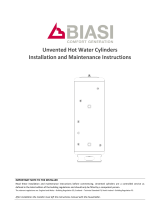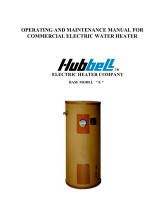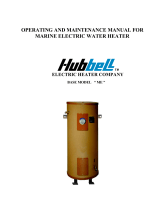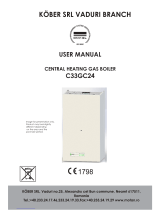Installation instructions DHW cylinders TSW-120/CSW-120
3048420_0707
9
Installation of the tundish
1. The tundish must be vertical and fitted within 500mm of the
temperature & pressure relief valve and must be located with
the cylinder. The tundish must also be in a position visible to the
occupants, and positioned away from any electrical devices.
The discharge pipe from the tundish should terminate in a safe
place where there is no risk to persons in the vincinity of the
discharge and to be of metal.
2. Discharge pipes from the temperature & pressure relief and
expansion relief valve may be joined together.
3. The pipe diameter must be at least one pipe size larger than the
nominal outlet size of the safety device unless it’s total
equivalent hydraulic resistance exceeds that of a straight pipe
9m long. i.e. Discharge pipes between 9m and 18m and
27 m at least 3 larger, and so on.
Bends must be taken into account in calculating the flow
resistance. Typical discharge pipe arrangement on page 10.
4. The discharge pipe must have a vertical section of pipe at least
300mm in length, below the tundish before any elbows or
bends in the pipework.
5. The discharge pipe must be installed with a continous fall.
6. The discharge must be visible at both the tundish and the final
point of discharge, but where this is not possible or practically
difficult; there should be clear visibility at one or other of these
locations. Examples of acceptance are:
i) Ideally below a fixed grating and above the w a t e r
seal in a trapped gully.
ii) Downward discharges at a low level; i.e. up t o
100mm above external surfaces such as c a r
parks, hard standings, grassed areas etc. Thes e
are acceptable providing that where children may play or
otherwise come into contact with discharges, a wire cage
or similar guard is positioned to prevent contact, whilst
maintaining visibility.
iii) Discharges at high level; l.e. into a metal hopper and metal
down pipe with the end of the discharge pipe clearly visible
(tundish visible or not). Or onto a roof capable of
withstanding high temperature discharges of water 3 m
from any plastic guttering systems that collect would such
a discharge (tundish visible).
iv) Where a single pipe serves a number of discharges, such
as in blocks of flats, the number served should be limited
to not more than 6 systems so that any installation can be
traced reasonably easily. The single common discharge
pipe should be at least one pipe size large than the largest
individual discharge pipe to be connected. If unvented hot
water storage systems re-installed where discharges
from safety devices may not be apparent l.e. in dwellings
occupied by the blind, infirm or disable people, consideration
should be given to the installation of an electronically
operated device to warn when discharge takes place.
Note: The discharge will consist of scalding water and
steam. Asphalt, roofing felt and non-metallic rainwater
goods may be damaged by such discharges.
Discharge pipework























